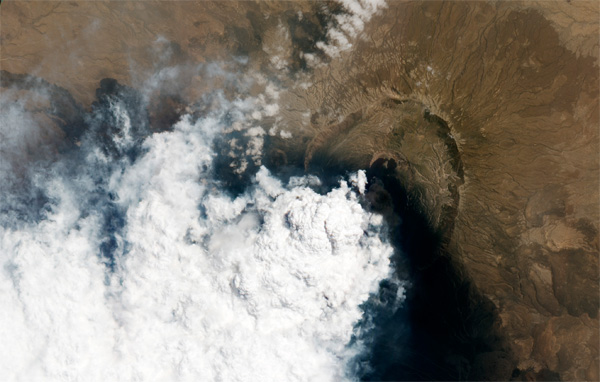The Asian summer monsoon (ASM) is a significant system in the Northern Hemisphere. Studying its influence on the transport and exchange of volcanic aerosols is of great significance for exploring the distribution of volcanic aerosols and their potential climate effects.
Erupting Nabro Volcano. The image is acquired by the Advanced Land Imager (ALI) aboard the Earth Observing-1 (EO-1) satellite on June 24, 2011, and distributed by NASA Earth Observatory.
Dr. WU Xue of the Key Laboratory of Middle Atmosphere and Global Environment Observation, IAP collaborated with scientists at Julich Supercomputing Centre in Germany retrieved realistic, altitude-resolved SO2 emissions of a middle-latitude volcanic eruption (Sarychev 2009) and a tropical volcanic eruption (Nabro 2011) and initialized the simulations of the long-range transport and dispersion of the sulfate aerosol plumes with the retrievals, to study the influence of the ASM system on the long-range aerosol transport.
Comparing the transport of the aerosols produced by the Sarychev eruption in 2009 and the Nabro eruption in 2011 under the influence of the ASM, they found that the ASM can enhance the quasi-horizontal meridional transport between the middle latitudes and the tropics. Furthermore, the horizontal barrier effect of the ASM anticyclone (ASMA) caused a significant aerosol gradient inside and outside the ASMA. In addition, driven by diabatic heating in the ASMA region, the volcanic aerosols entering the interior of the ASMA rise slowly and enter the stratosphere.
Wu concluded, "By enhancing the meridional transport in the UTLS region and lifting volcanic aerosols across the tropopause, the ASM significantly changed the distribution of volcanic aerosols in the Northern Hemisphere, especially in Asia, and expanded the potential effects of volcanic eruptions."
Citation: Wu, X. et al. The influence of the Asian summer monsoon on volcanic aerosol transport in the UTLS region. npj Clim Atmos Sci 6, 11 (2023). https://doi.org/10.1038/s41612-023-00339-w
Media contact: Ms. LIN Zheng, jennylin@mail.iap.ac.cn

